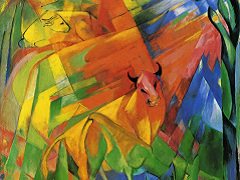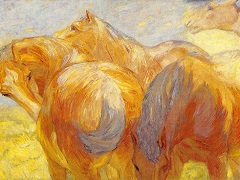Lenggries Horse by Franz Marc

Lenggries Horse Painting is perhaps the first work in which Marc reveals himself as the treat colorist he would become. the application of paint is viutuosolike. A light, airy quality, conveyed by the thinly applied pigment, vitalizes the scene. The painting foreshadows the ambitious et abandoned color and paint application of his most accomplished works and show Marc beginning to juxtapose primary colors in a single image. Orange in tonality, the horses have become visions unrelated to the palette of nature's horses.
Writing in 1910 about an unnamed large horse painting, Marc discussed the use of white behind red, yellow, and blue to suggest a wall, as if a fresco. This effect appears in the white expanse directly above the pink horse of Lenggries Horse Painting but is interrupted by a blue area.
While Marc had painted horses earlier, those versions often portray domesticated or placid animals. But Lenggries Horse Painting introduces the enormous vitality and vivid rendering that would characterize later paintings. It also shows another aspect typical of Marc's mature work - animals arranged rhythmically, yet with each indicating an individual and potentially emotional or symbolic attitude. This unity within which individuality of gesture exists is strikingly reminiscent of other large figurative compositions Marc would have been familiar with by Paul Cezanne, and Henri Matisse.




















